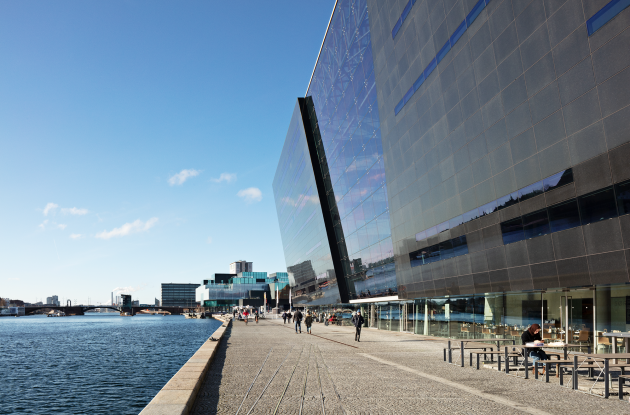About the building The Black Diamond
Royal Danish Library's buildings on Slotsholmen, better known as The Black Diamond, are more than just a popular library. The buildings have a long history which everyone is welcome to explore.

Photo: Laura Stamer
Royal Danish Library on Søren Kierkegaards Plads, Copenhagen extends across three very different buildings. Facing the water is The Black Diamond (1999), designed by the Danish architect group Schmidt Hammer Lassen Architects, in the centre of which Preben Hansen’s narrow extension (1968) stands, and at the back is H.J. Holm's historical library building from 1906, which is connected to the library garden.
Facts about The Black Diamond
- The building is shaped like a sculptural monolith.
- The building’s total volume is 20,733 m².
- In all, it contains 450 rooms and 800 doors, all requiring a key, distributed on eight floors.
- The front of The Black Diamond consists of 2,500 m² Absolute Black granite, mined in Zimbabwe and cut and polished in northern Italy. Each stone weighs 75 kg.
Art for eyes and ears
Both inside and outside The Black Diamond, there are works of art that can be seen and heard: Most spectacular is Per Kirkeby's 210 m2 large ceiling decoration over the bridge that connects The Black Diamond with the library's older buildings.
Are you lucky to be in the building at 1 p.m., The Black Diamond's central atrium is filled with sound art for a few minutes via a specially designed, built-in 12-channel speaker system. It is the composer Wayne Siegel who wrote the piece "Sky Mechanics". The work is generated in real time by a computer programme and can only be heard for 3-4 minutes, it is constantly changing as it is affected by the cycle of the moon. On Saturdays the music plays both at 10 a.m. and 1 p.m., and on Sundays at 11 a.m and 3 p.m.
Outdoors you can see Anne Marie Carl-Nielsen's expressive sculpture "Mermaid" with Olafur Eliasson's poetic "Circle Bridge" as a background. If you take a break on the maritime stairs at Søren Kierkegaards Plads, you can ponder the famous Søren Kierkegaard quote that life must be understood backwards
, which is written in the woodwork by the artist group FA + (Ingrid Falk and Gustavo Aguerre).
Find more works as you move around.